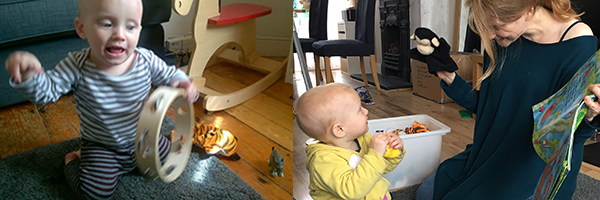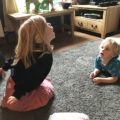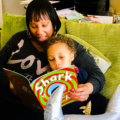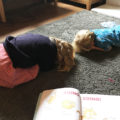Sharing poems, rhymes and songs
Ideas for sharing
-
Act out the rhymes as you read, share, sing them together
-
Leave spaces for children to guess or say the rhyming word.
-
Make a collection of favourite poems, rhymes and songs in a home-made book, with children’s own illustrations.
-
Read favourites together again and again so that children can memorise and say/sing them aloud.
-
Take it in turns to read/sing a line and both join in with the chorus (if there is one).
-
Use percussion (rattles, wooden spoon, clapping) to beat the rhythm of a poem or rhyme.
-
Play rhyming ping-pong. One person says a word, the other says a word that rhymes and you take it in turns until one person runs out of rhymes. Then start with another word. Keep the words short and simple to begin with.
Why sharing poems, rhymes and songs is important
Sharing poems hymes and songs with children is great fun and an important way for them to learn about language and reading. Children naturally tune in to rhythm and rhyme. It’s memorable and pleasurable and helps them to enjoy the patterns and sounds of language. Recognising the sounds of words, and the sounds in words, is helpful to children when they lean to read. Many picturebooks for young children are in rhyme because it’s so supportive for learning to read.
Singing songs and rhymes together, children learn to join in with the rhymes and choruses and to remember them. They also learn to play with language, experimenting by making up their own rhymes or changing rhymes they know well, such as: ‘Happy Birthday to you/ Squashed tomatoes and stew..’.
 Songs and rhymes are universal
Songs and rhymes are universal
Songs and rhymes are present in every culture and are an important way for children to learn about themselves, their world and their language. Rhymes teach children routines, rituals and information through action rhymes, alphabet and counting rhymes. They soothe and entertain through nursery rhymes, lullabies, jokes, story poems. They encourage sharing and joining in, creating a social experience.
Reading aloud and re reading a wide variety of poems is a wonderful way to build children’s confidence and enjoyment in books and reading.
See our Top 10 list of rhyming books
Read Michael Rosen on the importance of rhyme
Poetry books to try
Collections:
A Great Big Cuddle – see our activity page
Dear Mother Goose by Michael Rosen (Walker)
Here’s a little Poem by Polly Dunbar (Walker)
Little Miss Muffet and Other Rhymes by Patrick George (Patrick George)
My Very First Mother Goose by Rosemary Wells (Walker)
Here Comes Mother Goose by Rosemary Wells (Walker)
Mother Goose by Michael Foreman (Walker)
My Hat and All That by Tony Mitton (Corgi)
The Puffin Book of Fantastic First Poems by June Crebbin (Puffin)
Tasty Poems by Jill Bennett and Nick Sharratt (OUP)
Rhyming picture books: – see our activity pages
The Animal Boogie
Wheels on the Bus
The Owl and the Pussycat
Stomp Dinosaur Stomp
Orange Pear Apple Bear
Here Come the Aliens
Shark in the Park
Where’s my Teddy?
The Gruffalo
We’re Going on a Bearhunt
Each Peach Pear Plum





 Follow lovemybooksUK15
Follow lovemybooksUK15